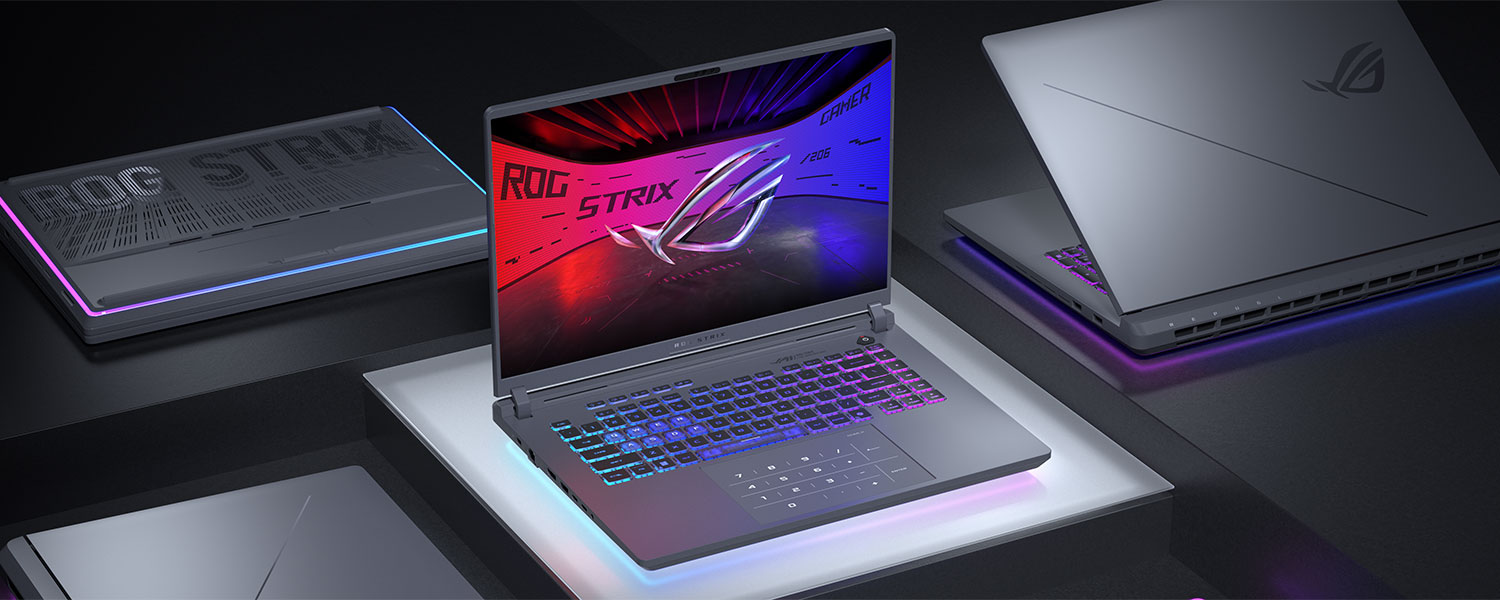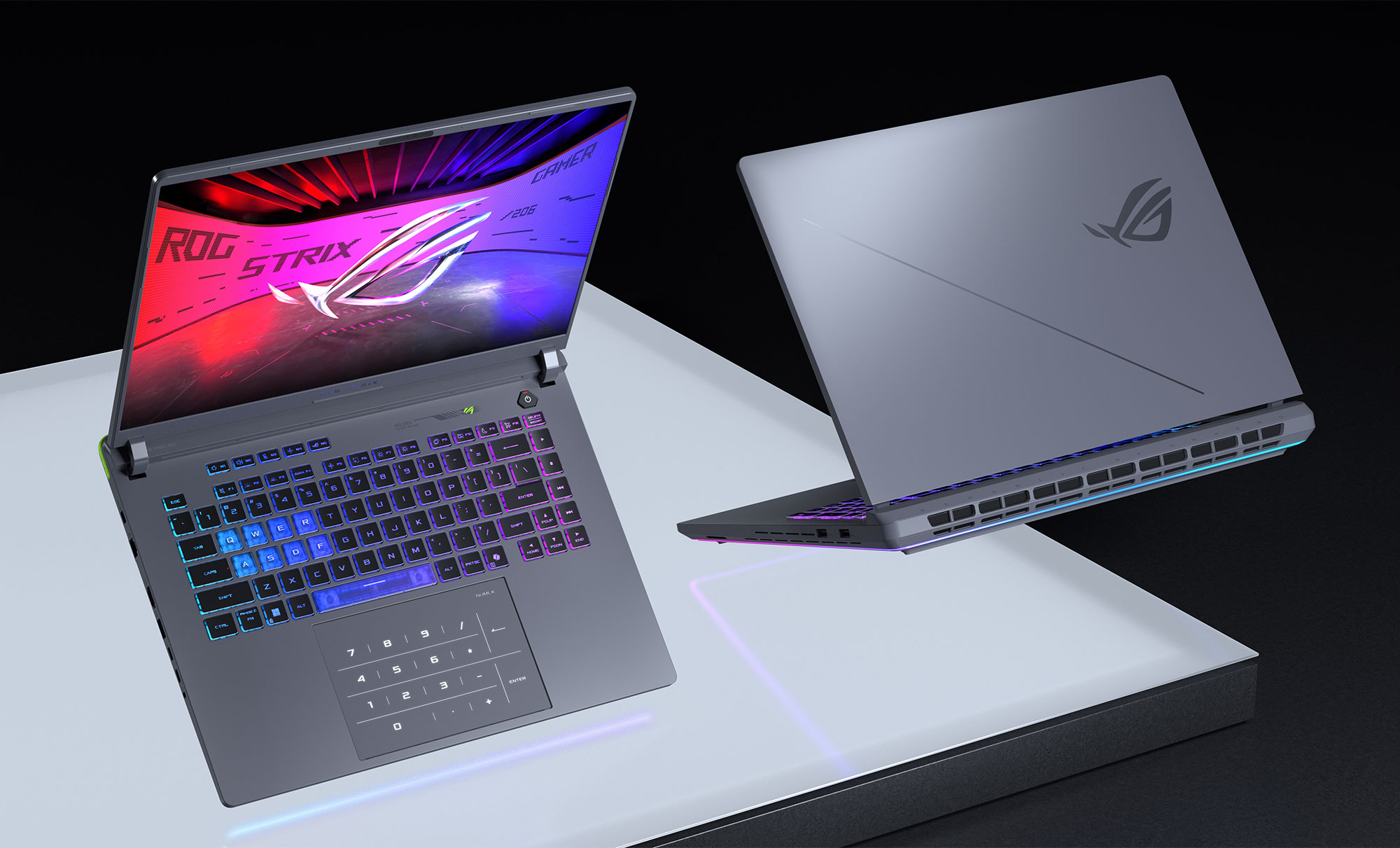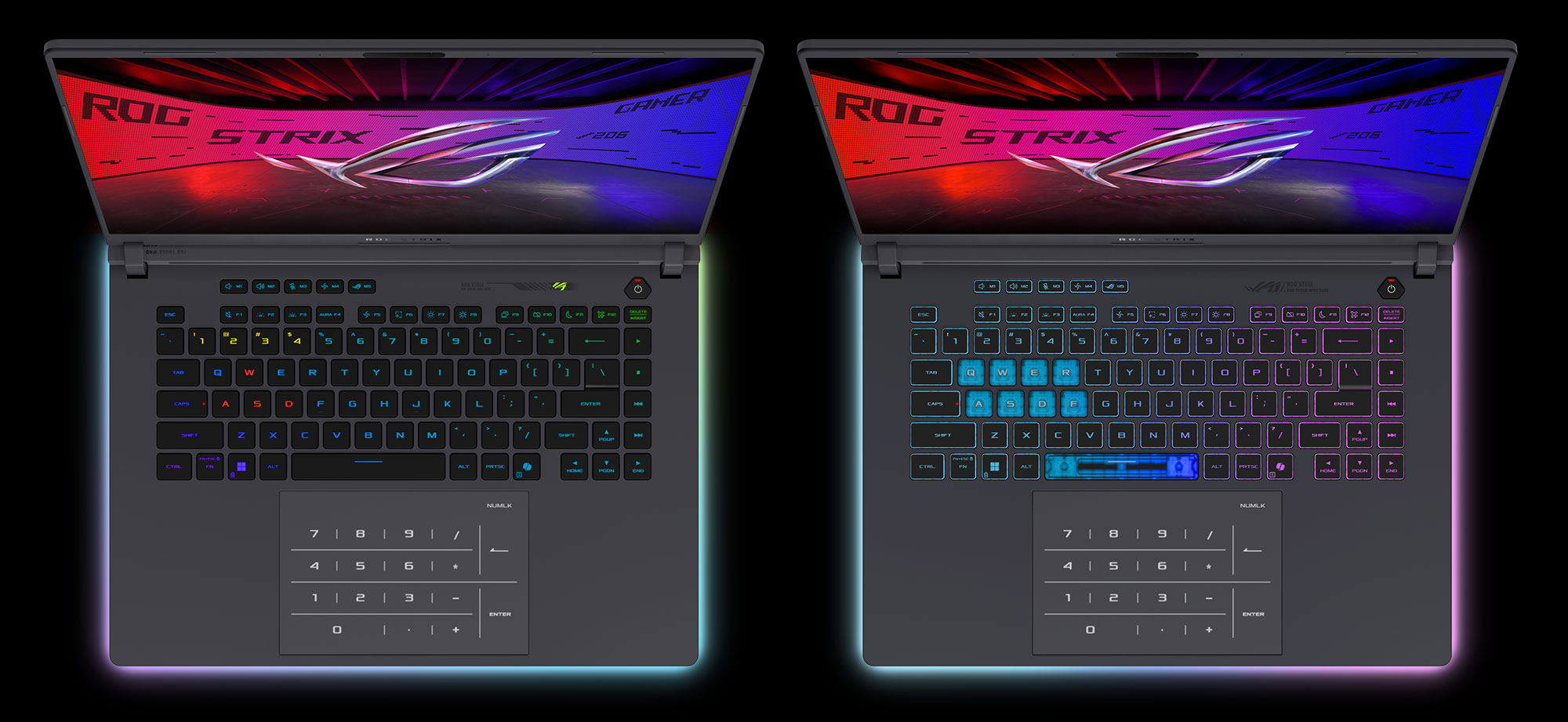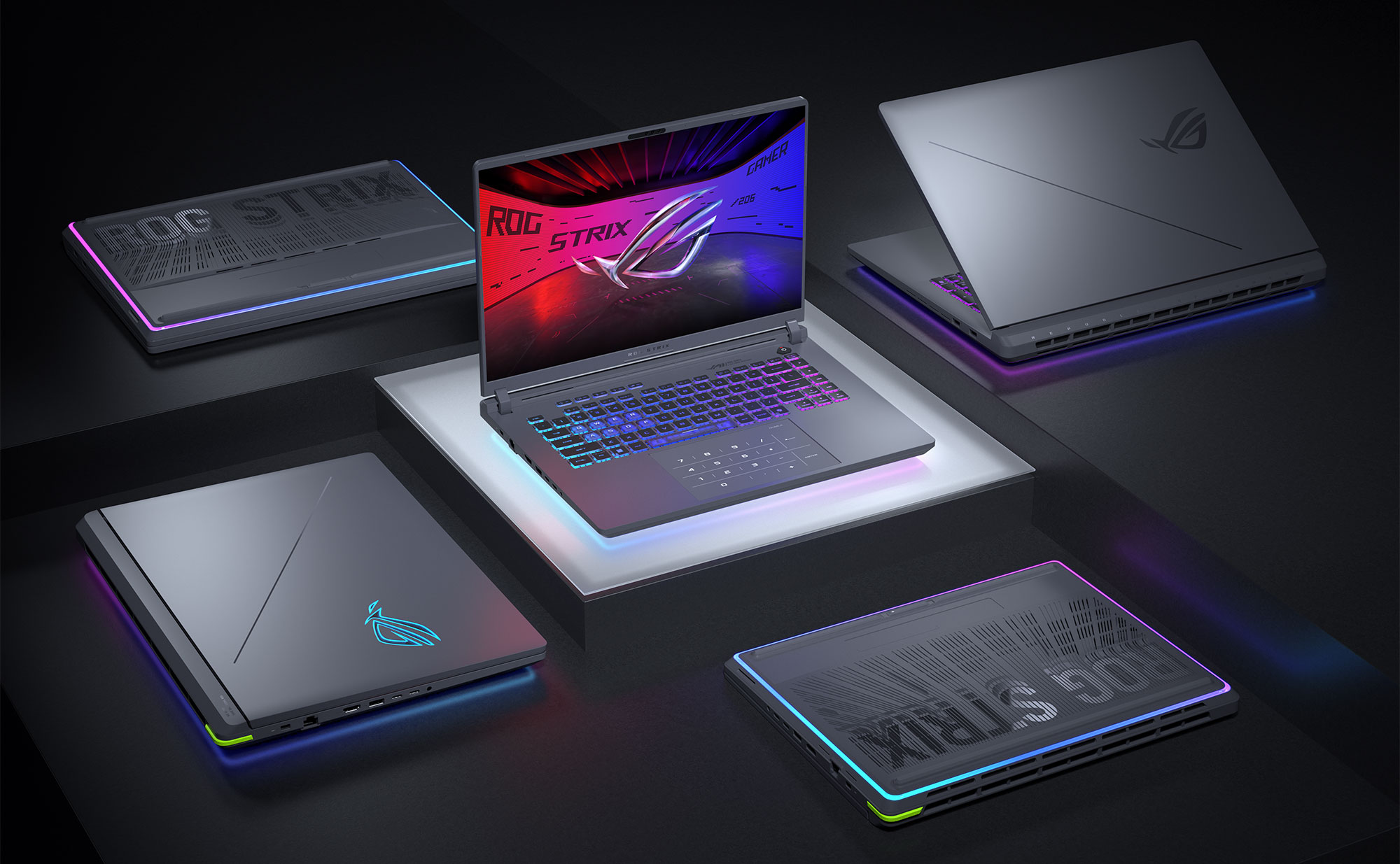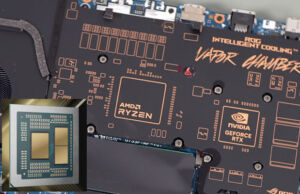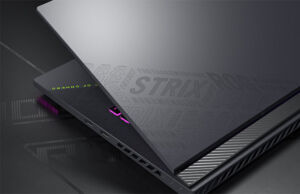Table of Contents
Alongside their ROG Scar lineups, Asus are also updating their more mainstream ROG Strix G models for 2025.
These Strix Gs G615/G815 are a brand-new designs for the year and share many characteristics with the higher-tier 2025 Scars G635/G835. In fact, both the 16-inch G16 and the 18-inch G18 implement the same chassis as their Strix Scar counterparts, but with a few differences: the lid is simpler and doesn’t include the Anime Vision array, the cooling is a more traditional module with heatsinks and not with a vapor-chamber and on the Scars, and the hardware configurations only go up to an RTX 5080 dGPU, leaving the 5090 exclusive to the Scars.
Asus are also going to offer these Strix G models in a wider range of specs, starting with mid-level GPUs once they’re available. At launch, they start at an RTX 5070 version, for around $1999 MSRP in North America. For comparison, the Scar 16 starts at $2499, but for a higher-specced model. For what is worth, both these Strix G and the Strix Scar models are exclusively based on Intel Arrow Lake-HX and Nvidia RTX 5000 Blackwell hardware.
We’ll have our detailed reviews of these laptops in the following weeks and months, but in the meantime, here are the specs sheets and a summary of what’s changed over the previous Strix G models and what to expect from these 2025 generations.
| 2025 ASUS ROG Strix G16 G615 | 2025 ASUS ROG Strix G18 G815 | |
| Display | 16-inch, 16:10, non-touch, matte Nebula QHD+ 2560 x 1600 px IPS, 240 Hz 3ms, 500-nits, 100% DCI-P3 |
18-inch, 16:10, non-touch, matte Nebula QHD+ 2560 x 1600 px IPS, 240 Hz 3ms, 500-nits, 100% DCI-P3 |
| CPU | Intel Arrow Lake-HX, Core Ultra 9 275HX | |
| GPU | Arc + up to Nvidia GeForce RTX 5080 16GB (up to 175W TGP with Dyn Boost) with MUX, Advanced Optimus, GSync |
|
| Memory | up to 64 GB DDR5-5600 (2x DIMMs) | |
| Storage | 2x M.2 PCIe 5.0 SSD slots | |
| Connectivity | WiFi 7 (Intel) 2×2 with Bluetooth 5.4, 2.5Gigabit LAN | |
| Ports | Left: power, 2.5G Lan, up to 2x USB-C with Thunderbolt 5, 1x USB-A 3.2 gen 2, HDMI 2.1 FRL, audio jack Right: 2x USB-A 3.2 gen2 |
|
| Battery | 90Wh, up to 380W power adapter, USB-C charging up to 100W | |
| Size | 354 mm or 13.94” (w) x 268 mm or 10.55″ (d) x 23 – 31 mm or .9″ – 1.21” (h) |
399 mm or 15.71” (w) x 298 mm or 11.73″ (d) x 23.6 – 32 mm or .93″ – 1.26” (h) |
| Weight | from 2.73 kg (6.02 lbs) + charger | from 3.42 kg (7.54 lbs) + charger |
| Extras | clamshell metal designs with 140-degree screens, gray color with optional green accent, per-key RGB backlit keyboard (with NumPad on the Scar 18), large glass?? touchpad, 1080p IR camera, quad speakers ??, updated tri-fan cooling module with liquid metal |
|
The code names with a 5 at the end differentiate these latest designs from the previous chassis ending in a 4. But Asus keep things confusing with their naming schemes. For example, the Strix G16 G615 is the new Intel-based 2025 chassis, while the Strix G16 G614 are both previous gen models from 2023/2024, as well as 2025 updates with AMD Fire Range hardware, but still based on the previous chassis design.
Design and ergonomics
The design is cleaner on these new Strix models than on past iterations, with a dark gray color scheme and none of the graphical markups implemented on the lid and main deck by the previous Strix G versions. I like it. I’d even argue I prefer this approach over the Scars that get a darker Off-Black color (that smudges easier) and that extra Anime Visual array on the lid, which I found to be mostly a gimmick on past Zephyrus models that implemented one. It’s a nice wow factor at first, sure, but fades away into oblivion after the first few days. Plus, with the simple lid design, these laptops are better suited for stricter work and school environments, as long as you switch off the ROG lights.
For this Strix generation, Asus implemented a 360-light bar that goes all around the laptop, as well as that ROG backlit logo on the lid. I hope that’s controllable as well in the software, like in the Scars, and not panel-lit.
As a side note, the specs mention an Eclipse Grey and a Green Web color variant for these Strix models. The first is all gray, while the latter gets a small bright green accent on the back edge.
Aesthetics aside, though, the ergonomics of this new Strix G series are still hit and miss. On one hand, the laptops sit firmly anchored on a desk and the front lips are blunted and friendly on the wrists, an important detail on this sort of thicker full-size design that sits a little higher off the desk than a slimmer portable model. On the other, the screen still doesn’t lean back flat, which isn’t an issue for desk use but is limiting for lap use, and the ports are still lined mostly on the left edge, as the back of the laptop is entirely reserved for cooling.
On a positive note, though, these ports are no longer squeezed towards the front of the chassis, as on the previous Strix, as the cooling design allowed for more space on these sides since side heatsinks are no longer implemented. Instead, the cooling relies solely on a large rear heatsink. More on that in a bit.
It’s also worth adding that these Strix models are a little lighter in weight than the Scars, most likely due to not implementing vapor-chamber cooling. The differences are small though, within 100-200 grams.
As far as that IO goes, there’s mostly everything you’ll want here, including two USB-C ports with Thunderbolt 5.0 support (although lower-tier models only get TB4 and a USB-C 3.2). There’s’ still no card reader or lock, though, not even on the 18-inch model. And it’s unclear to me whether these Strix models implement 4x speakers, with up-firing tweeters positioned under the display, like on the Scars. In the past, the Strix G models only came with bottom speakers.
As far as inputs go, Asus implemented a large touchpad on these Strix G generations, with the one on the Strig G16 acting as a virtual NumberPad. The 18-inch model doesn’t need it, since it implements a keyboard with an actual NumPad section.
The keyboards should be quite similar to the ones in the past Strix models, but there will be two variants available between configurations, once with per-key RGB control and all-black keycaps, and another with 4-zone lighting and partially translucent keycaps. I prefer the former.
As for the displays, both sizes are offered with good-quality IPS panels, with QHD+ resolution, 240Hz refresh and 3 ms response with Overdrive, around 1200:1 contrast ratio, around 500-nits max brightness and 100% DCI-P3 color coverage. These are the best you can get with a matte IPS these days. In comparison, though, the Scars offer mini LED panels with zone dimming, allowing for deeper blacks and contrast.
Hardware and specs – Core Ultra 9 275HX with up to GeForce RTX 5080
These ROG Strix G models are built on an Intel Arrow Lake-HX hardware platform, namely on the Core Ultra 9 275HX processor, with 2x RAM slots, 2x PCIe 5.0 slots, and the latest RTX 5000 dGPUs from Nvidia, up to the GeForce RTX 5080 16GB.
There’s no AMD hardware option for these exact G16 G615 and G18 G815 models, instead, Asus are offering AMD Fire Range configurations on refreshed variants on the previous G16 G614 and G18 G814 models, with a Ryzen 9 9955HX3D processor and up to RTX 5070Ti graphics.
The Core Ultra 9 275HX is pretty much identical to the Ultra 9 285HX implemented in the Scars, with minimally lower max speeds. Otherwise, it’s the same hybrid design with 24 cores and 32 Threads. Asus might decide on running this at slightly lower sustained power than in the Scars, though, due to the difference in cooling between the two.
While the Scars implement a vapor chamber with some extra heatpipes around the rear heatsink, the Strix model relies entirely on a cooling module with multiple heatpipes, but otherwise a similar set of three fans and a massive heatsink that goes along the entire rear edge. Unlike on past Strix models, there are no side exhaust vents anymore, which means hot air is only pushed out to the back of the laptop, while those side cuts on the edges are for air admission.
Asus also redesigned the bottom of the laptop, which still focuses on cutouts for ventilation. But the d-panel is probably still a tool-less design, as on the Scars, allowing for easier access to the RAM and SSD slots. Speaking of, the M.2 SSD slots on these Strix laptops support PCI 5.0 speeds, but the laptops will only ship with PCIe 4.0 drives, unlike the Scars which will get faster gen5 drives out of the box. Shouldn’t matter for most of you, but it’s something to consider in your decisions between the two series.
On the GPU side, expect most Strix G models to be offered in stores with RTX 5070 and 5070Ti for now, and most likely lower-tier CPUs and GPUs later in the year. Asus mention specs up to an RTX 5080, but based on past experience, I expect you’ll rarely find 5080 Strix configurations, as the higher tier GPU options are usually reserved for the Strix Scars. You might still find the Strix G18 with a 5080 in some markets, though.
Overall, I’m curious about the differences in cooling capacity between the Scars and the Strix models on the 5080 175 GPU. I’d reckon the Scars should run cooler and quieter at similar specs, hence why the Strix will mostly be offered with the 140W mid-range GPUs instead. That 35W difference between a 5070 and a 5080 is significant, and will allow the mid-specced Strix notebooks to run coolly and quietly even at full power.
The list of specs is completed by a 90W battery paired with either a 280W or 380W charger, based on configurations.
All in all, the ROG Strix G lineups are among the best-selling Asus performance and gaming laptops, and have been some of the most competitive options in their space over the years. Much like in the past, these 2025 updates don’t aim at being affordable, but rather at offering a complete middle-ground experience, with good build quality and balanced aesthetics, good inputs, a beautiful display, and an oversized cooling module for the mid-level configurations, which should keep thermals at bay with limited noise and ensure comfortable use in sustained loads and good long term reliability. That has been the recipe for past Strix G16 and Strix G18 iterations, and it doesn’t seem to have changed with these 2025 models.
We’ll know more once we get to test and review these. Stay around.

